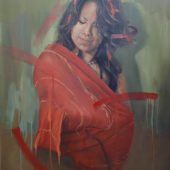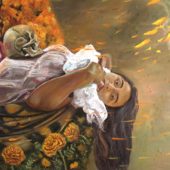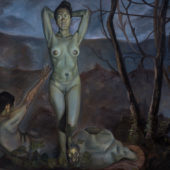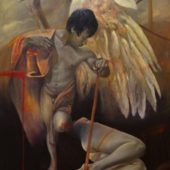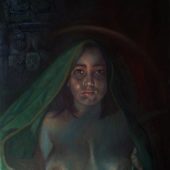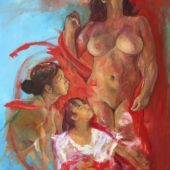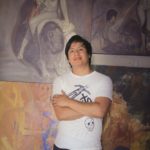
Heber GoRo
Location:
Chiapas, Mexico
In my work I recurrently approach the theme of “the suit” (the indigenous costume) as one of the pillars of collective identity, just as the body is to the individual identity. In my community the circumstance of women is that of submission, therefore I believe that taking off “the suit” calls for the empowerment of the body.
The intimate and the public; identity, for me, comes in this order. I am interested in the moment of transition when “the suit” is off, becoming the naked body, not the isolated body beneath the clothing. I am interested in that moment, the ephemeral.
“The suit” represents the Zoque Being, (the body is mine, it is yours). I think that in some way the women of my community claim “the suit” is no longer in their bodies, the body no longer belongs to the community. The woman who takes off her “suit” strips away from the collective identity, what I believe, empowers the body, and empowers her intimacy.
The patriarchal culture in which we are immersed identifies the female body as a source of eroticism, the woman then stripped of the costume refers to a brand, an erotic western code, a patriarchal order. It is in this transition, the moment of stripping the costume away(collective identity), that in my works I take the body to the erotic or to the feminine, (intimate identity). What interests me is to bring my works closer to the expression of collective identity and others to the individual identity of the intimate, of the feminine.
The process of study, preparation and elaboration of this series on body and clothing are the results of experiences and training anecdotes. The models that I represent in my works have never imagined posing without any clothes on. When I questioned a younger model about what she thought about the nude body, she replied that the body should not be shown, much less to strangers; but when I explained in depth about my project she changed her mind and decided to be part of it.
Later I had the opportunity to work with an older woman, she willingly lent herself to pose for the photographs wearing the suit and also without it. When asking the same question that I asked the young model, she replied: “I am not sorry to show my body, because it is normal and I grew up with a very old woman, my mother lived daily without her blouse on and that’s how I remember my mom and I live again what I once was, now I’m happy to feel it again “. In these works I hope to raise an idea that evokes the intimate space and the relationship between the body, the identity and the inheritance associated with Zoque women.
I make my works with oil on canvas and in different sizes. This technique has helped me to build a pictorial practice around figuration around body and portrait. The oil painting has allowed me to refine the realistic representation that my proposal requires, on the other hand the pastels and gestures makes reference to the instantaneous or ephemeral of a past moment that I want to recreate. Tapalapa is a cold place, but with the warm colors I pretend to give that feeling of warmth making reference to the intimacy and comfort of the family, of union.
I am currently inspired by the book “Postinjk jäyä”, by maestro Huberto Saraos Díaz. My recent work talks about the most popular legends and stories of my people, of Tapalapa; they talk about eroticism and death. This moves my works in a new direction from what I have already built, but with a more subtle, more poetic eroticism.
The body persists as the main focus of my work.
Read about Arteria Chiapas, the Mexican organization giving a space to young artists
The intimate and the public; identity, for me, comes in this order. I am interested in the moment of transition when “the suit” is off, becoming the naked body, not the isolated body beneath the clothing. I am interested in that moment, the ephemeral.
“The suit” represents the Zoque Being, (the body is mine, it is yours). I think that in some way the women of my community claim “the suit” is no longer in their bodies, the body no longer belongs to the community. The woman who takes off her “suit” strips away from the collective identity, what I believe, empowers the body, and empowers her intimacy.
The patriarchal culture in which we are immersed identifies the female body as a source of eroticism, the woman then stripped of the costume refers to a brand, an erotic western code, a patriarchal order. It is in this transition, the moment of stripping the costume away(collective identity), that in my works I take the body to the erotic or to the feminine, (intimate identity). What interests me is to bring my works closer to the expression of collective identity and others to the individual identity of the intimate, of the feminine.
The process of study, preparation and elaboration of this series on body and clothing are the results of experiences and training anecdotes. The models that I represent in my works have never imagined posing without any clothes on. When I questioned a younger model about what she thought about the nude body, she replied that the body should not be shown, much less to strangers; but when I explained in depth about my project she changed her mind and decided to be part of it.
Later I had the opportunity to work with an older woman, she willingly lent herself to pose for the photographs wearing the suit and also without it. When asking the same question that I asked the young model, she replied: “I am not sorry to show my body, because it is normal and I grew up with a very old woman, my mother lived daily without her blouse on and that’s how I remember my mom and I live again what I once was, now I’m happy to feel it again “. In these works I hope to raise an idea that evokes the intimate space and the relationship between the body, the identity and the inheritance associated with Zoque women.
I make my works with oil on canvas and in different sizes. This technique has helped me to build a pictorial practice around figuration around body and portrait. The oil painting has allowed me to refine the realistic representation that my proposal requires, on the other hand the pastels and gestures makes reference to the instantaneous or ephemeral of a past moment that I want to recreate. Tapalapa is a cold place, but with the warm colors I pretend to give that feeling of warmth making reference to the intimacy and comfort of the family, of union.
I am currently inspired by the book “Postinjk jäyä”, by maestro Huberto Saraos Díaz. My recent work talks about the most popular legends and stories of my people, of Tapalapa; they talk about eroticism and death. This moves my works in a new direction from what I have already built, but with a more subtle, more poetic eroticism.
The body persists as the main focus of my work.
Read about Arteria Chiapas, the Mexican organization giving a space to young artists

